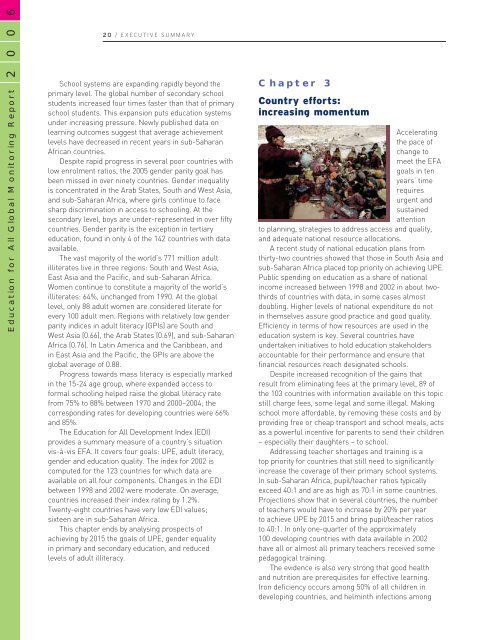literacy for life; EFA global monitoring report, 2006 - Institut de ...
literacy for life; EFA global monitoring report, 2006 - Institut de ...
literacy for life; EFA global monitoring report, 2006 - Institut de ...
You also want an ePaper? Increase the reach of your titles
YUMPU automatically turns print PDFs into web optimized ePapers that Google loves.
0<br />
0<br />
6<br />
20 / EXECUTIVE SUMMARY<br />
2<br />
Education <strong>for</strong> All Global Monitoring Report<br />
School systems are expanding rapidly beyond the<br />
primary level. The <strong>global</strong> number of secondary school<br />
stu<strong>de</strong>nts increased four times faster than that of primary<br />
school stu<strong>de</strong>nts. This expansion puts education systems<br />
un<strong>de</strong>r increasing pressure. Newly published data on<br />
learning outcomes suggest that average achievement<br />
levels have <strong>de</strong>creased in recent years in sub-Saharan<br />
African countries.<br />
Despite rapid progress in several poor countries with<br />
low enrolment ratios, the 2005 gen<strong>de</strong>r parity goal has<br />
been missed in over ninety countries. Gen<strong>de</strong>r inequality<br />
is concentrated in the Arab States, South and West Asia,<br />
and sub-Saharan Africa, where girls continue to face<br />
sharp discrimination in access to schooling. At the<br />
secondary level, boys are un<strong>de</strong>r-represented in over fifty<br />
countries. Gen<strong>de</strong>r parity is the exception in tertiary<br />
education, found in only 4 of the 142 countries with data<br />
available.<br />
The vast majority of the world’s 771 million adult<br />
illiterates live in three regions: South and West Asia,<br />
East Asia and the Pacific, and sub-Saharan Africa.<br />
Women continue to constitute a majority of the world’s<br />
illiterates: 64%, unchanged from 1990. At the <strong>global</strong><br />
level, only 88 adult women are consi<strong>de</strong>red literate <strong>for</strong><br />
every 100 adult men. Regions with relatively low gen<strong>de</strong>r<br />
parity indices in adult <strong>literacy</strong> (GPIs) are South and<br />
West Asia (0.66), the Arab States (0.69), and sub-Saharan<br />
Africa (0.76). In Latin America and the Caribbean, and<br />
in East Asia and the Pacific, the GPIs are above the<br />
<strong>global</strong> average of 0.88.<br />
Progress towards mass <strong>literacy</strong> is especially marked<br />
in the 15-24 age group, where expan<strong>de</strong>d access to<br />
<strong>for</strong>mal schooling helped raise the <strong>global</strong> <strong>literacy</strong> rate<br />
from 75% to 88% between 1970 and 2000–2004; the<br />
corresponding rates <strong>for</strong> <strong>de</strong>veloping countries were 66%<br />
and 85%.<br />
The Education <strong>for</strong> All Development In<strong>de</strong>x (EDI)<br />
provi<strong>de</strong>s a summary measure of a country’s situation<br />
vis-à-vis <strong>EFA</strong>. It covers four goals: UPE, adult <strong>literacy</strong>,<br />
gen<strong>de</strong>r and education quality. The in<strong>de</strong>x <strong>for</strong> 2002 is<br />
computed <strong>for</strong> the 123 countries <strong>for</strong> which data are<br />
available on all four components. Changes in the EDI<br />
between 1998 and 2002 were mo<strong>de</strong>rate. On average,<br />
countries increased their in<strong>de</strong>x rating by 1.2%.<br />
Twenty-eight countries have very low EDI values;<br />
sixteen are in sub-Saharan Africa.<br />
This chapter ends by analysing prospects of<br />
achieving by 2015 the goals of UPE, gen<strong>de</strong>r equality<br />
in primary and secondary education, and reduced<br />
levels of adult il<strong>literacy</strong>.<br />
Chapter 3<br />
Country ef<strong>for</strong>ts:<br />
increasing momentum<br />
Accelerating<br />
the pace of<br />
change to<br />
meet the <strong>EFA</strong><br />
goals in ten<br />
years’ time<br />
requires<br />
urgent and<br />
sustained<br />
attention<br />
to planning, strategies to address access and quality,<br />
and a<strong>de</strong>quate national resource allocations.<br />
A recent study of national education plans from<br />
thirty-two countries showed that those in South Asia and<br />
sub-Saharan Africa placed top priority on achieving UPE.<br />
Public spending on education as a share of national<br />
income increased between 1998 and 2002 in about twothirds<br />
of countries with data, in some cases almost<br />
doubling. Higher levels of national expenditure do not<br />
in themselves assure good practice and good quality.<br />
Efficiency in terms of how resources are used in the<br />
education system is key. Several countries have<br />
un<strong>de</strong>rtaken initiatives to hold education stakehol<strong>de</strong>rs<br />
accountable <strong>for</strong> their per<strong>for</strong>mance and ensure that<br />
financial resources reach <strong>de</strong>signated schools.<br />
Despite increased recognition of the gains that<br />
result from eliminating fees at the primary level, 89 of<br />
the 103 countries with in<strong>for</strong>mation available on this topic<br />
still charge fees, some legal and some illegal. Making<br />
school more af<strong>for</strong>dable, by removing these costs and by<br />
providing free or cheap transport and school meals, acts<br />
as a powerful incentive <strong>for</strong> parents to send their children<br />
– especially their daughters – to school.<br />
Addressing teacher shortages and training is a<br />
top priority <strong>for</strong> countries that still need to significantly<br />
increase the coverage of their primary school systems.<br />
In sub-Saharan Africa, pupil/teacher ratios typically<br />
exceed 40:1 and are as high as 70:1 in some countries.<br />
Projections show that in several countries, the number<br />
of teachers would have to increase by 20% per year<br />
to achieve UPE by 2015 and bring pupil/teacher ratios<br />
to 40:1. In only one-quarter of the approximately<br />
100 <strong>de</strong>veloping countries with data available in 2002<br />
have all or almost all primary teachers received some<br />
pedagogical training.<br />
The evi<strong>de</strong>nce is also very strong that good health<br />
and nutrition are prerequisites <strong>for</strong> effective learning.<br />
Iron <strong>de</strong>ficiency occurs among 50% of all children in<br />
<strong>de</strong>veloping countries, and helminth infections among

















